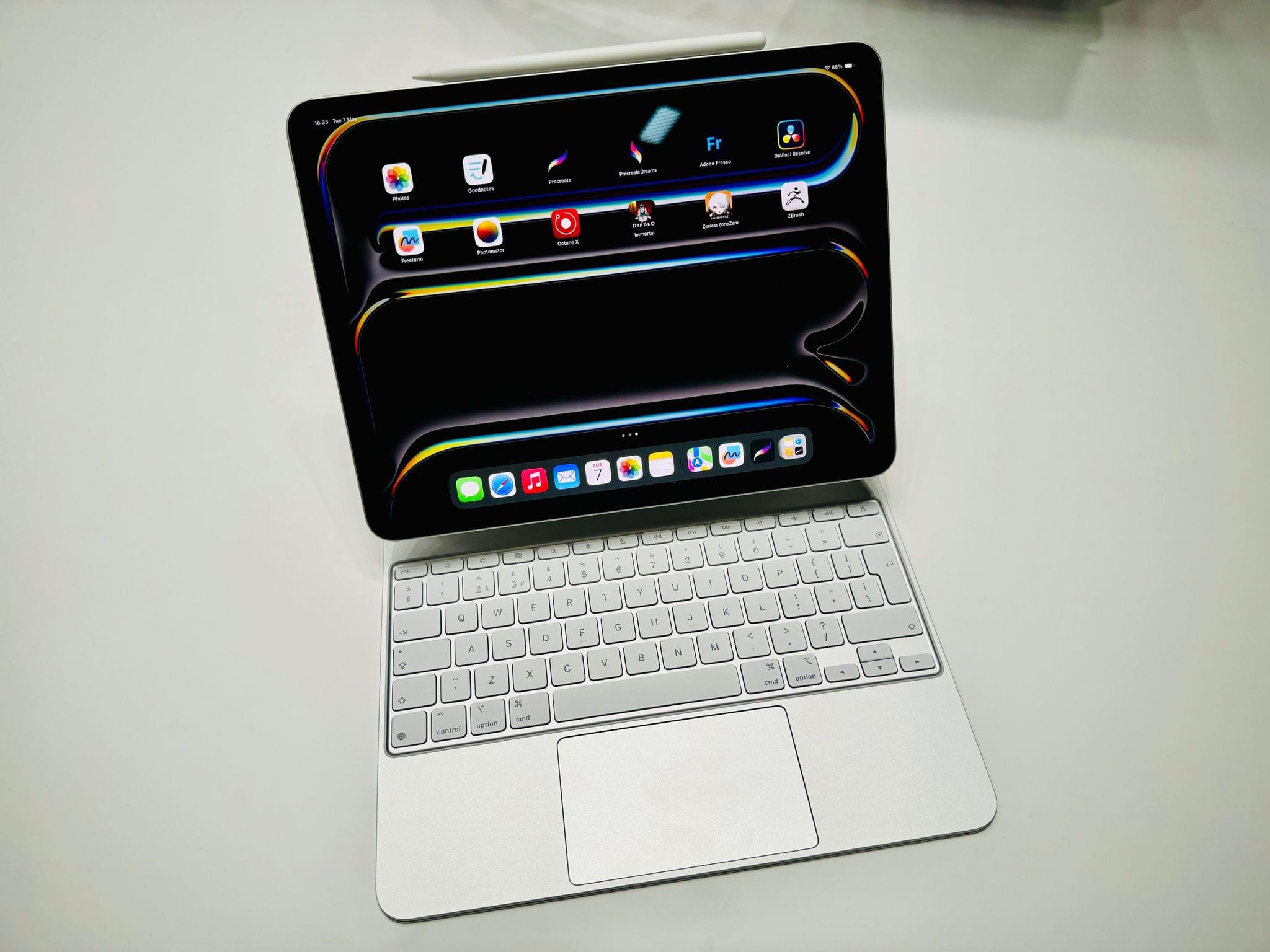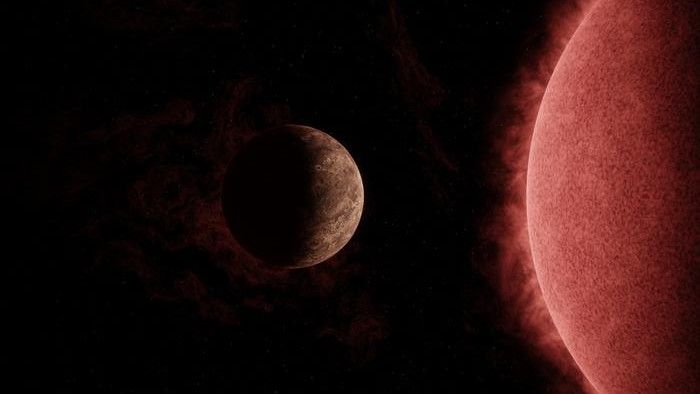I just came back to my hotel from the media event Apple held earlier today in London at their Battersea Power Station headquarters. I had high expectations for the new generation of iPad Pros that Apple unveiled today – some of which were exceeded by reality (hardware), and others that were, regrettably but unsurprisingly, faced with the reality of the iPad platform (software).
What follows is a loose collection of notes and impressions from the event, where I was able to try both iPad Pro models multiple times and spend some quality time with their accessories.
Let’s dive in.
Notes on Apple’s Battersea Location
Before we get to the iPads, I have to spend a few words on how stunning Apple’s office space at Battersea Power Station in London is. I knew from photos and general knowledge that there was something special about the history of Battersea and the work Apple had done there, but seeing it in real life for the first time truly is something else. The scale of the building is remarkable, and it hits you in a different way than, say, Apple Park’s ring does. It’s tall.
What I didn’t know about Battersea is that the lower-level floors are a mall, with Apple’s offices taking up the higher floors. It immediately struck me that, the way Apple renovated Battersea Power Station, it feels like a place that sits somewhere in between Apple Park and, say, the Via del Corso Apple Store in Rome. Much like the city of London itself is a fascinating mix of modern architecture and old structures, so is Battersea a blend of old and new. The contrast between brick walls and the modern wood and glass that Apple added everywhere is a recognition of the building’s historical importance mixed with contemporary touches that we know from Apple’s retail stores.
Most of all, Apple’s Battersea HQ feels like a welcoming place for media gatherings, which is why I hope Apple will continue hosting similar events here in the future. Apple set up a stage and chairs in the office’s atrium, which is a large open space surrounded by balconies where everyone can see you and you can see everyone. No offense to Cupertino, but simply looking around and taking in the scene here was a lot cooler than sitting under a tent at Apple Park:
Apple’s Battersea office is unmistakably a European place with a strong European vibe. Apple Park is remarkable for a lot of different reasons, but after years of media events in the United States, I have to say: today felt nice. I hope Apple does more events here. I could easily see a “European WWDC” happening at and around Battersea in the future.
The New iPad Pros: OLED, Thinness… and iPadOS
Alright, let’s get to the iPads.
First, I have to come clean and admit that I didn’t even go see the new 13” iPad Air in person. The stars of the show were the new iPad Pros. I think the larger iPad Air will make for an excellent tablet for most people who want an iPad with a good keyboard, but the more interesting story today was Apple’s strategy for the high end of the iPad lineup. The fact that the iPad Air demo tables at the hands-on area were always half-empty was proof of that.
The first thing I noticed when picking up the new 13” iPad Pro wasn’t the new OLED display (more on this below); it was the thinness and lightness. It’s hard to convey in an article what it felt like, but I’ll try: the 13” model feels impossibly thin and light. At 5.1mm, the 13” iPad Pro is now 1.3mm thinner than before, and in the process, Apple also shaved off 103 grams from the device’s weight (579 grams vs. 682 grams in the old model). Both are impressive reductions that I felt right away when I picked up the larger iPad Pro. I will have to use this device for prolonged sessions to make a final assessment, but after holding it with one hand for a minute, I couldn’t feel the same pressure I did with the previous-gen model.
The thinness and reduced weight of the big iPad Pro are making me question which model I want to use going forward. I went into this event knowing I’d get an 11” iPad Pro again, but after trying the new 13” in person, I’m not so sure anymore. It’s still a large tablet that’s not as portable as the small one, but the thinness and lightness of it are making reconsider my decision. I can’t get over how wildly thin and light the new 13” iPad Pro feels.
I guess I’m feeling this way because the 11” iPad Pro – although finally on par with the 13” in terms of display technology – didn’t see quite the same leap in terms of thickness and weight.
The small iPad Pro is 5.3mm thin (0.2mm more than the 13” iPad Pro), and it “only” lost 20 grams (446 grams vs. the old 466 grams) in the transition to OLED. Don’t get me wrong: the 11” still feels like you’re holding the “right” tablet – small enough to use one-handed, and large enough in landscape to use it with a keyboard attached. I speak from experience here since I’m actually using macOS (with smaller UI elements than iPadOS) on my 11” iPad Pro, and it’s totally fine. It’s just that when you pick up the new 11” iPad Pro, it doesn’t wow you like the thinner and lighter 13” model does.
I have a theory regarding what Apple has done here, and it revolves around the company’s approach to each device’s built-in battery. The 11” iPad Pro features a bigger battery than before, going from a 28.65-watt-hour battery to a 31.29-watt-hour one, and the device only lost 20g and 0.6mm. Conversely, the big iPad Pro features a smaller battery than before, going from a 40.88-watt-hour battery to a 38.99-watt-hour one, and the device has lost 1.3mm and 103g. However, both models are advertised as having the same battery life as before: up to “10 hours of surfing the web on Wi-Fi or watching video”.
Also worth keeping in mind: the new iPad Pros have new display resolutions with more pixels that need to be pushed than before. The 11” iPad Pro has gone from 2388×1668 to 2420×1668 (3,983,184 pixels vs. 4,036,560 pixels – a 1.3% increase), while the 13” iPad Pro has gone from 2732×2048 to 2752×2064 (5,595,136 pixels vs. 5,680,128 pixels – a 1.51% increase).
My theory is that Apple prioritized different aspects of the iPad experience for each model and chose different trade-offs for the two sizes. Given the weight reduction granted by OLED and the lower power draw made possible by the M4, I can imagine that they may have chosen to make their most common tablet size (the 11” one) as thin as possible, but not dramatically so. At the same time, I have a feeling Apple wanted to make the unwieldy 12.9” iPad Pro a lot more accessible than it used to be, hence the smaller battery that is, however, compensated for by the M4, which promises the same battery life as before despite the smaller capacity and increased pixel resolution.
Are these the right trade-offs? I can’t answer that question today, but I’m curious to find out. The one thought I still can’t shake is that, on the 13” iPad Pro, Apple’s own Thunderbolt cable connector is thicker than the device itself:
Speaking of the display: you’ll be shocked to hear that OLED (or as Apple calls it, their “Tandem OLED” tech) looks incredible in real life. I’ll want to try my own content on those displays (I can’t wait to stream PC games and play Nintendo Switch games on them), but from what I saw at the hands-on area, colors were vivid and vibrant, blacks were true, deep blacks, and both displays were bright. If there’s an OLED version of a product, I’m always going to get it, and I can’t wait to spend more time with these OLED iPad Pros. I’m especially intrigued to test dark mode interfaces with OLED’s true blacks, which I didn’t do today.
I was able to play around with the nano-texture display too, and while I’m going to need more time with it, I came away impressed. At first glance with a regular iPad Pro and a nano-texture one side by side, I couldn’t see the difference. According to Apple, they’re using a new chemical process to alter the glass with nano textures, which ensures the display keeps the same properties as the glossy one – same brightness, same contrast. However, as soon as an Apple employee grabbed the iPad with the nano-texture display and started moving it around, I could see the difference: the overhead spotlights were not reflecting on it as much as they were on the other iPad Pro, and even fingerprints on the display looked different.
At the hands-on area, I couldn’t discern a loss in quality and color reproduction between the two displays, but I hope I’ll have the chance to try both in the near future and judge Apple’s claims for myself. What I wasn’t expecting when I grabbed the iPad Pro with the nano-texture display was that the display felt as smooth as the regular glossy one. The best way I can describe it is that the nano-texture iPad Pro looks like a nicer version of the Paperlike screen accessory that doesn’t degrade image quality and is also smooth to the touch. If you were expecting this matte option to feel rough like paper, this is not it, and I’m glad Apple went in this direction. An 11” iPad Pro with a matte OLED display sounds like an incredibly intriguing proposition for a device that can be your main computer and a tablet you can use outside or, dare I say it, at the beach.
I know what you’re all thinking, though. I went into this event with a MacPad on my hands (literally) and left with a new generation of iPad Pros that are an amazing hardware revision powered by the same lackluster software as before.
The elephant in the room, which I plan to address more in-depth in a future story, is that while the iPad Pro’s hardware was fine before and is finer now, its software was a letdown before, and nothing has changed after today’s event. I don’t need to rehash why I think Apple is missing a huge opportunity by not embracing the iPad Pro as a machine that could do both iPadOS and macOS equally well in the same package. I’ll save that for iPadOS 18 at WWDC. What I will say is that if there was a gap between the older-generation iPad Pro hardware and its software, that gap is now a Tears of the Kingdom-sized chasm between these thin, OLED iPad Pros and iPadOS 17.
Apple can’t seem to break out of this loop they’ve been in for the past six years with the iPad Pro: state-of-the-art, bleeding-edge hardware running software that underutilizes it. Will the even better hardware of these new iPad Pros be enough to offset the limitations of iPadOS? Is there more to these iPads when it comes to software that will be revealed at WWDC next month? Do you feel like you’ve heard these questions before?
The Accessories
I was also able to play around with the iPad Pro’s new accessories today.
The Apple Pencil Pro’s squeeze gesture and associated haptic feedback feel great. You squeeze the pencil, and a radial menu appears on-screen in apps that use the native PencilKit framework, allowing you to choose which tools you want to use. (Third-party apps can reprogram this gesture to show different UIs.) Squeezing the Pencil and getting the haptic feedback feels like squeezing the AirPods Pro’s stem, but there is real, tactile feedback since there’s a haptic motor inside the new Pencil. I dig it, and the addition of a gesture is a nice way to simplify the interface while still providing quick access to drawing tools. I’m not much of a Pencil user myself, but I look forward to playing around with it in different apps.
I was obviously more interested in the new Magic Keyboard, and I think Apple pretty much delivered what I wanted. The new Magic Keyboard has the same key mechanism and outer-facing cover as before; however, the keyboard now has a function row, the inner part (the palm rest) is made of aluminum, and it has a larger glass trackpad that supports the same haptic feedback previously seen in Mac laptops.
The new Magic Keyboard is, effectively, the definitive version of the original design from 2020. The cantilever-based floating mechanism is here to stay (as is the Smart Connector), and everything else around it has been fine-tuned for pro users. I always found the previous trackpad a little too cramped for my hands, so I’m glad to see a larger version; my white Magic Keyboard aged horribly in the inner part despite my care, so I think the aluminum body will help; the addition of a function row means I’ll never have to make the trip to Control Center again to adjust display brightness or control media playback, which is terrific and a huge “finally”. Somehow, the new Magic Keyboard also felt lighter than the previous one, but this is something I’ll have to double-check in a future review.
There are two details I noticed with the new Magic Keyboard that I want to point out. When you close the keyboard shut on the iPad Pro, it now makes a nice, satisfying “click”, which I liked a lot.
Furthermore, the keyboard has a color-matched, rubber (I think it’s rubber?) ridge that runs across its entire perimeter, which likely serves as protection for the display when the keyboard is closed. I like how this frames the keyboard and that the rounded edges unsurprisingly match the curvature of the iPad Pro and Magic Keyboard itself.
Open Questions
Of course, I left the event with a lot of questions about the iPad Pro’s hardware and software:
Is the new Magic Keyboard more difficult to open? Myke mentioned this when we were at one of the hands-on tables, then I noticed another journalist struggling with opening the Magic Keyboard, and when I tried it, I experienced it myself. Since the edge of the keyboard is now flush aluminum without an inset “lip” like on MacBooks, it’s hard to know at first where you’re supposed to grab it. I’m keen to see how quickly I can get used to this design, but I also wonder why it wasn’t designed like MacBook keyboards.
How will third-party apps handle the new iPad Pro’s display resolutions? If a developer hasn’t updated their iPad app for the new screen sizes, will the app get letter/pillar-boxed, or automatically scale to fill the screen?
Is the function row on the new Magic Keyboard hard to access? We knew this was going to be the case, but the cantilever design of the Magic Keyboard does seem to make the function row a little too hard to access sometimes. Depending on the angle the iPad is at, your fingers will likely bump into its bottom edge. Again, I need to use the device more, but I noticed this at the event today.
How will the M4 impact “normal usage” of the iPad Pro in everyday life? The improvements in Logic and Final Cut Pro look fantastic, but those apps are not for me. Given the limitations of iPadOS, it’s hard for me to imagine what I – someone who doesn’t edit video or audio – will notice in terms of performance improvements granted by the M4. I suppose that having the same battery life with thinner iPads will have to be it.
My Next Decisions
I came away from today’s Apple event with two thoughts:
- I want Apple to hold more media events at Battersea in the future.
- I know I’m going to get a new iPad Pro, but I’m not sure about which size anymore.
Let’s face it: I didn’t go into this event thinking that my iPad Pro’s thickness was the problem. But at the same time, after seeing and holding a 5.1/5.3mm OLED tablet – optionally with a matte display – I would lie if I said I didn’t want one immediately. In many ways, these new iPad Pros are the ultimate expression of the design language introduced in 2018: impossibly thin and approaching the limit of the USB-C port’s height, with an outstanding display technology, and with better accessories.
The problem was, is, and will continue to be the iPad’s operating system, which doesn’t provide users with nearly as many capabilities as macOS does on laptops that are now even behind the iPad Pro when it comes to M-series chips.
The thing is, however, despite my grudges with iPadOS, there is no other tablet or laptop I want to use in my life made by any other tech company. Believe me, I’ve tried them all over the past year, from a Surface Pro to a OnePlus Open foldable that I never mentioned before. None of the alternatives are as compelling as an all-in-one package as an iPad Pro if what you’re looking for is a tablet that can transform into a laptop. And now these iPads are going to feel even nicer to hold and use thanks to the slimmer profile, reduced weight, and OLED displays.
This is probably not the sort of inflammatory take that’s going to make this story go viral, but my opinion is that you can still love the iPad’s hardware for what it is and criticize its software for what it’s not. As I have explained, the alternative – just getting a regular Mac laptop and calling it a day – is not for me. I’d rather keep pushing the limits of what my iPad Pro can do and make my case for radical changes to iPadOS than give up on a form factor that makes computing more fun and pleasant for me.
And so here I am, back in my hotel room in London, thinking about whether I want to stick with my original plan and get an 11” OLED iPad Pro or return to the 13” model because of its newfound thinness and lightness. Glossy display or nano-texture one? 512 GB model or 1 TB model to get access to 16 GB of RAM and the 10-core M4?
The road to iPad Pro happiness has always been paved with questions and compromises, and today’s event has followed the same trajectory. Life is easier for Mac users: most of them pick a MacBook Air and are done. And they’re happy! The iPad Pro is a complicated product, part of a complicated lineup, with a complicated software story. And yet, for many of us, it also remains the only clear answer for a particular type of hybrid computer that we want in our lives. The kind of computer with the kind of app ecosystem that, frankly, no one else makes.
Just like six years ago, I’m wondering, “Where does the iPad Pro go from here?” There’s only one way to find out: to be along for a bumpy ride.
You can follow all of our May 2024 Apple event coverage through our May 2024 Apple event hub or subscribe to the dedicated May 2024 Apple event RSS feed.

Sophie Anderson, a UK-based writer, is your guide to the latest trends, viral sensations, and internet phenomena. With a finger on the pulse of digital culture, she explores what’s trending across social media and pop culture, keeping readers in the know about the latest online sensations.








